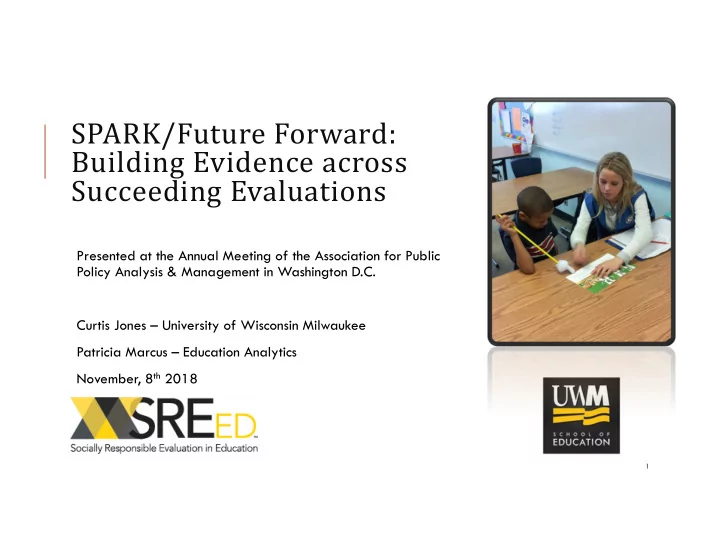

SPARK/Future Forward: Building Evidence across Succeeding Evaluations �������������������������������������������������������������� ����������������������������������������������� �������������� ��������������������������� ��!��� ����������������� "������������������ #�������$�% �� &'(% )����**+,� ����� �
History of SPARK Early Literacy/Future Forward 2005 – SPARK was created by Boys & Girls Clubs of Greater Milwaukee (BGCGM) and piloted at one site in Milwaukee Public Schools (MPS). 2006 – SPARK was expanded to three MPS schools with funding from the United Way and AmeriCorps. 2010 – BGCGM received an Investing in Innovations (i3) Development grant award to expand SPARK to seven more schools (10 total). 2017 – Education Analytics received an Education Innovation and Research (EIR) mid-phase grant to expand to 15 mostly rural schools across 3 states under the name Future Forward. � SPARK/MCLP EVALUATION
SPARK/Future Forward Approach SPARK/Future Forward combines in-school tutoring with family engagement efforts to address the literacy needs of K through 2 nd grade students and families. Each school has a certified teacher or youth serving professional who oversees the tutoring by community members. In in-school tutoring, students are pulled out of non-core classes and taken to the SPARK/Future Forward room three times per week for 30 minutes. Tutors engage in a number of literacy activities with students including word play, reading a book at instructional level, writing sentences, and tutor read aloud. For family engagement, SPARK/Future Forward sends home monthly newsletters, holds monthly family events, and has ongoing check-ins with all participating families. �
2010-11 through 2014-15 i3 Study of SPARK/Future Forward Develop buy-in and trust between Clubs Milwaukee and MPS. Continue to modify the program model and hone implementation. Conducted two randomized studies of its impact. The first study found a small positive impact of SPARK/Future Forward on the reading achievement of participants. Attrition was high. SPARK/Future Forward was found to be ineffective with Kindergarten students. The second study found a significant positive impact on reading achievement, regular school day attendance and literacy. SPARK/Future Forward had a much greater impact on lower achieving students. SPARK/Future Forward had a significant positive impact across all grade levels. �
SPARK/Future Forward After i3 Boys & Girls Clubs of America missed winning an i3 expansion grant in 2015. Education Analytics narrowly missed winning an i3 expansion grant in 2016. Education Analytics was award an EIR mid-phased grant in 2017 to expand SPARK/Future Forward to 15 mostly rural schools across three sites. �
2018-19 through 2020-21 SPARK/Future Forward EIR project Education Analytics in designing scalable systems that will promote the sustainability of SPARK/Future Forward beyond the grant. Education Analytics is working to make SPARK/Future Forward more cost effective. This project again has a rigorous evaluation design that will involve a regression-discontinuity evaluation in 2018-19 and two randomized studies in 2019-20 and 2020-21. The evaluation will again focus on literacy and school attendance. For this grant, student social-emotional development is also an outcome. �
Partially as a result of i3/EIR funding SPARK/Future Forward… Has two studies included in the What Works Clearinghouse (WWC) and determined to meet their design standards without reservations. Is featured on the Evidence for ESSA website as a program with a STRONG effectiveness rating. Prior to i3, there was no evidence of its effectiveness. Participated in meetings at the capital building, San Francisco, and at the national AmeriCorps conference. Was able to obtain foundation funding to continue SPARK/Future Forward in Milwaukee. Was able to obtain additional federal funding and foundation funding to expand SPARK/Future Forward to clubs in eight states. �
Partially as a result of i3/EIR funding and evaluation requirements SPARK/Future Forward… Continues to exist Has strong evaluation evidence of its effectiveness Is a more effective program Better understands its program delivery model Is nationally recognized Has become a model program for community-based education organizations Is on the verge of scaling up to become an option to schools across the U.S. �
Recommend
More recommend